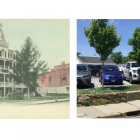Now & Then
New Canaan Now & Then: Mead Park
|
On April 12, 1915, Florence Heath Mead, wife of Benjamin P. Mead, donated “18 acres, more or less,” to the town of New Canaan. There were a few stipulations: (1) that the property “shall be known as the ‘Mead Memorial Park”; (2) that its only use could be as a park; (3) parts of the park could only be sold to the New Haven & Hartford Railroad Company or its successors; and (4) that $300 be set aside for maintenance and improvements.
Benjamin Mead had been a very active member of the town. He first moved to New Canaan in 1873 to manage a general store located on Main Street where Chase Bank is today. He later went on to be town clerk, first selectman, legislator, senator, and state comptroller. He apparently never lost an election. He died in 1913. Looking to memorialize him, Mead’s friends suggested donating land that Benjamin had purchased in 1895 from the Rockwells. A former cranberry bog and a cornfield, it had been a gravel pit under Mead’s ownership. By 1915, gravel had been extracted and local residents used the land as a dump. The proposed donation of the land caused an uproar in town. A town hall meeting on the subject attracted some 350 residents. While the attendees were waiting outside for the meeting to begin, they debated the pros and cons of accepting the gift, including the tax burden and that the land would be “another sewer bed for a playground site.” But despite these objections, the land gift was accepted in a 136 to 110 vote.
Not too much was done with the park in the first few years. The first goals were to build a ballfield and a skating pond. The field was measured out, but it took until 1920 before there was something resembling a baseball field in the park.




